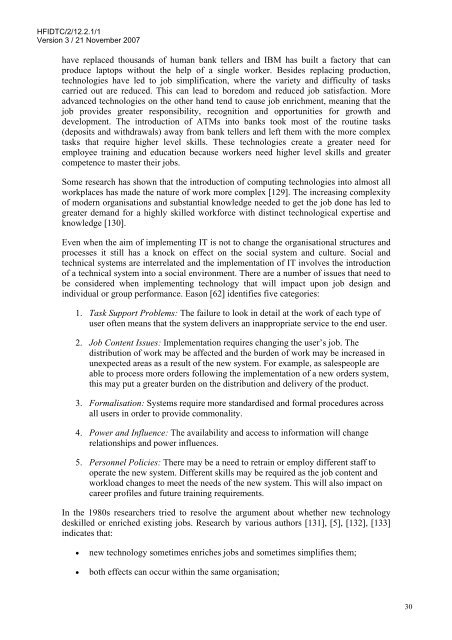The Impact of Technology Insertion on Organisations
The Impact of Technology Insertion on Organisations
The Impact of Technology Insertion on Organisations
You also want an ePaper? Increase the reach of your titles
YUMPU automatically turns print PDFs into web optimized ePapers that Google loves.
HFIDTC/2/12.2.1/1<br />
Versi<strong>on</strong> 3 / 21 November 2007<br />
have replaced thousands <str<strong>on</strong>g>of</str<strong>on</strong>g> human bank tellers and IBM has built a factory that can<br />
produce laptops without the help <str<strong>on</strong>g>of</str<strong>on</strong>g> a single worker. Besides replacing producti<strong>on</strong>,<br />
technologies have led to job simplificati<strong>on</strong>, where the variety and difficulty <str<strong>on</strong>g>of</str<strong>on</strong>g> tasks<br />
carried out are reduced. This can lead to boredom and reduced job satisfacti<strong>on</strong>. More<br />
advanced technologies <strong>on</strong> the other hand tend to cause job enrichment, meaning that the<br />
job provides greater resp<strong>on</strong>sibility, recogniti<strong>on</strong> and opportunities for growth and<br />
development. <str<strong>on</strong>g>The</str<strong>on</strong>g> introducti<strong>on</strong> <str<strong>on</strong>g>of</str<strong>on</strong>g> ATMs into banks took most <str<strong>on</strong>g>of</str<strong>on</strong>g> the routine tasks<br />
(deposits and withdrawals) away from bank tellers and left them with the more complex<br />
tasks that require higher level skills. <str<strong>on</strong>g>The</str<strong>on</strong>g>se technologies create a greater need for<br />
employee training and educati<strong>on</strong> because workers need higher level skills and greater<br />
competence to master their jobs.<br />
Some research has shown that the introducti<strong>on</strong> <str<strong>on</strong>g>of</str<strong>on</strong>g> computing technologies into almost all<br />
workplaces has made the nature <str<strong>on</strong>g>of</str<strong>on</strong>g> work more complex [129]. <str<strong>on</strong>g>The</str<strong>on</strong>g> increasing complexity<br />
<str<strong>on</strong>g>of</str<strong>on</strong>g> modern organisati<strong>on</strong>s and substantial knowledge needed to get the job d<strong>on</strong>e has led to<br />
greater demand for a highly skilled workforce with distinct technological expertise and<br />
knowledge [130].<br />
Even when the aim <str<strong>on</strong>g>of</str<strong>on</strong>g> implementing IT is not to change the organisati<strong>on</strong>al structures and<br />
processes it still has a knock <strong>on</strong> effect <strong>on</strong> the social system and culture. Social and<br />
technical systems are interrelated and the implementati<strong>on</strong> <str<strong>on</strong>g>of</str<strong>on</strong>g> IT involves the introducti<strong>on</strong><br />
<str<strong>on</strong>g>of</str<strong>on</strong>g> a technical system into a social envir<strong>on</strong>ment. <str<strong>on</strong>g>The</str<strong>on</strong>g>re are a number <str<strong>on</strong>g>of</str<strong>on</strong>g> issues that need to<br />
be c<strong>on</strong>sidered when implementing technology that will impact up<strong>on</strong> job design and<br />
individual or group performance. Eas<strong>on</strong> [62] identifies five categories:<br />
1. Task Support Problems: <str<strong>on</strong>g>The</str<strong>on</strong>g> failure to look in detail at the work <str<strong>on</strong>g>of</str<strong>on</strong>g> each type <str<strong>on</strong>g>of</str<strong>on</strong>g><br />
user <str<strong>on</strong>g>of</str<strong>on</strong>g>ten means that the system delivers an inappropriate service to the end user.<br />
2. Job C<strong>on</strong>tent Issues: Implementati<strong>on</strong> requires changing the user’s job. <str<strong>on</strong>g>The</str<strong>on</strong>g><br />
distributi<strong>on</strong> <str<strong>on</strong>g>of</str<strong>on</strong>g> work may be affected and the burden <str<strong>on</strong>g>of</str<strong>on</strong>g> work may be increased in<br />
unexpected areas as a result <str<strong>on</strong>g>of</str<strong>on</strong>g> the new system. For example, as salespeople are<br />
able to process more orders following the implementati<strong>on</strong> <str<strong>on</strong>g>of</str<strong>on</strong>g> a new orders system,<br />
this may put a greater burden <strong>on</strong> the distributi<strong>on</strong> and delivery <str<strong>on</strong>g>of</str<strong>on</strong>g> the product.<br />
3. Formalisati<strong>on</strong>: Systems require more standardised and formal procedures across<br />
all users in order to provide comm<strong>on</strong>ality.<br />
4. Power and Influence: <str<strong>on</strong>g>The</str<strong>on</strong>g> availability and access to informati<strong>on</strong> will change<br />
relati<strong>on</strong>ships and power influences.<br />
5. Pers<strong>on</strong>nel Policies: <str<strong>on</strong>g>The</str<strong>on</strong>g>re may be a need to retrain or employ different staff to<br />
operate the new system. Different skills may be required as the job c<strong>on</strong>tent and<br />
workload changes to meet the needs <str<strong>on</strong>g>of</str<strong>on</strong>g> the new system. This will also impact <strong>on</strong><br />
career pr<str<strong>on</strong>g>of</str<strong>on</strong>g>iles and future training requirements.<br />
In the 1980s researchers tried to resolve the argument about whether new technology<br />
deskilled or enriched existing jobs. Research by various authors [131], [5], [132], [133]<br />
indicates that:<br />
• new technology sometimes enriches jobs and sometimes simplifies them;<br />
• both effects can occur within the same organisati<strong>on</strong>;<br />
30

















